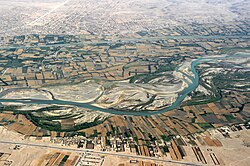Arghandab River
The Arghandab is a river in Afghanistan, about 400 km (250 mi) in length.
It rises in Ghazni Province, west of the city of Ghazni, and flows southwest, passing near the city of Kandahar, before joining the Helmand River 30 km (19 mi) below the town of Grishk. In its lower course, it is much used for irrigation, under the control of the Helmand and Arghandab Valley Authority, and the valley is cultivated and populous; yet the water is said to be somewhat brackish. It is doubtful whether the ancient Arachotus is to be identified with the Arghandab or with its chief confluent the Tarnak, which joins it on the left 50 km (31 mi) southwest of Kandahar. The Tarnak, which flows south of Kandahar, is much shorter (length about 320 km or 200 miles) and less copious.
| Arghandab River | |
|---|---|
 | |
| Native name | Arghandaw rod (Pashto) |
| Location | |
| Country | Afghanistan |
| Cities | Kandahar Lashkargah |
| Physical characteristics | |
| Source | |
| • location | North of Sang-e-Masha |
| • coordinates | 33°26′12″N 67°31′00″E / 33.436630°N 67.516588°E |
| Mouth | |
• location | Lashkargah |
• coordinates | 31°25′57″N 64°23′01″E / 31.432381°N 64.383568°E |
| Length | 400 km (250 mi) |
Historical background

The river was known to the ancient Iranians as the Haraxvaiti in Avestan and Harahuvati in Old Persian, which are cognate with Rigvedic Sarasvati (as described in its "family books"). Scholars such as Boyce and Parpola have identified Greek Arachosia as a Hellenization of the name, meaning the land of the Haraxvaiti. Rigveda's hymn VI.61.2 describes it with the words:
By means of her gushing and powerful waves, this (Sarasvatī) has crushed the ridge of the mountains, (breaking river banks) like a man who digs for lotus roots; with praises and prayers, we solicit Sarasvatī for her help, (Sarasvatī) who slays the foreigners.
Historian Asko Parpola states: "Arghandab [...] descends from a height of nearly four kilometers down to about 700 meters when it joins the Helmand River, which eventually forms shallow lakes." Sarasvatī- is interpreted to mean "full of lakes".
Some historians, however, assert that the Avestan Haraxvaiti as well as the Rigvedic Sarasvati refer to the Helmand River. The Rigvedic name of Arghandab is then believed to be Drishadvati.
The ruins at Ulan Robat, supposed to represent the city of Arachosia, are in its basin; and the lake known as Ab-i Istada, the most probable representative of Lake Arachotus, is near the head of the Tarnak, though not communicating with it. The Tarnak is dammed for irrigation at intervals, and almost dries up in the summer.
Upper course

This section needs expansion. You can help by adding to it. (April 2018) |
The upper course of the Arghandab river is relatively unexplored. The Historical and Political Gazetteer of Afghanistan cites the explorations of Major G. Lynch in 1841, according to whom the origin of the Arghandab is 20 to 30 miles north of Sang-e-Masha. This places the source in the mountains southwest of the Nawar basin. Lynch also described the upper course of the river as being a "mountain torrent, dashing over great granite rocks and about 3 feet deep where fordable".
Lower course

There is a good deal of cultivation along the river, but few villages. The Kabul-Kandahar Highway passes this way (another reason for supposing the Tarnak to be Arachotus), and the people live off the road to avoid the onerous duties of hospitality.
Dahla dam
In 2008 a project was initiated to rehabilitate the Dahla Dam and associated irrigation system.
See also
Notes
References
Bibliography
- Adamec, Ludwig W., ed. (1980), Historical and Political Gazetteer of Afghanistan, Vol. 5 (PDF), Akademische Druck- u. Verlagsanstalt, ISBN 978-3-201-01125-9
- Parpola, Asko (2015), The Roots of Hinduism: The Early Aryans and the Indus Civilization, Oxford University Press Incorporated, ISBN 978-0190226923
External links

- Distance Learning Module 3 - Rivers of the Hindu Kush, Pamir, and Hindu Raj, the University of Nebraska, Center for Afghanistan Studies, Retrieved 15 April 2018.
This article uses material from the Wikipedia English article Arghandab River, which is released under the Creative Commons Attribution-ShareAlike 3.0 license ("CC BY-SA 3.0"); additional terms may apply (view authors). Content is available under CC BY-SA 4.0 unless otherwise noted. Images, videos and audio are available under their respective licenses.
®Wikipedia is a registered trademark of the Wiki Foundation, Inc. Wiki English (DUHOCTRUNGQUOC.VN) is an independent company and has no affiliation with Wiki Foundation.
